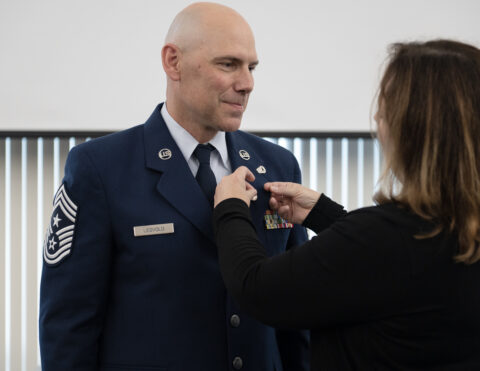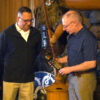A year in the Guard: a new chapter for chief

Life in the military requires a significant commitment. At first, for those joining the National Guard, the classic “One weekend a month, two weeks a year” sounds simple and manageable enough. Over the years, though, those weekends add up. The annual training periods add up. Deployments have become almost inevitable, as well. If that gets extrapolated to 20 years or more, that really adds up.
What happens when that commitment is fulfilled? How does one cope with suddenly having power over that time again?
As the recently retired former command chief of the Minnesota National Guard’s 133rd Airlift Wing, Mark Legvold has found himself exploring answers to those questions.
“Last time we talked I was literally on my way to a job interview with a pretty big leadership consulting organization. That was a great merge of my two different ways of life. They provide leadership training to farm credit services of 56-member banks,” said Legvold. “I went through three stages of that interview process—learned a ton, but they wanted me to travel 50% of the time.”
The recent retiree expressed to this potential employer that a career opportunity which required that much travel was not something in which he was interested. He politely declined the offer, but rather than keep searching for the right opportunity, he decided to create his own.
“So I have an LLC,” Legvold said. “Two of the things I’ve enjoyed the most is teaching, especially teaching leadership, and sharing what I’ve known. Teaching people how to be good to other human beings at work—nobody likes a bad boss, right?”
Now, as his own boss, Legvold will be able to work as much or as little as he wants at his new business. He can allow himself all the time he needs to do the necessary work of the family farm in Northfield, Minnesota. Before, he would have to balance his farm duties with the duties of being a full-time employee elsewhere. Now he can be more balanced in dedicating time to both farming and consulting.



“During harvest season I [used to] work almost a full day and then come home and work until about nine-thirty, ten o’clock at night, then do it all over again,” he explained. “But it’s a season, and it goes by very, very quickly.”
For Mark Legvold, the requirement to rush and repeat is over. While still being dedicated to the mission of teaching, developing, and mentoring leaders, he has opportunities beyond the confines of being a uniformed member of the military.
“Who we are is so diverse when it comes to our people that serve and I think when people think of the stereotypical military person, they see the stereotype,” explained Legvold. “We’re good human beings with big hearts and we’re a very open organization and that story I don’t think gets told often enough.”
A unique piece of the military is that everyone is in a position where the best thing they can do is work themselves out of a job. In September, Chief Legvold was part of a change of responsibility ceremony which welcomed his successor into his role. Even with complete faith and confidence in the incoming command chief, Legvold still had to manage the emotions that come with winding down a career of service.
“’The military is an organization built for people to love one another,’” Legvold said, reflecting on a quote he’d heard years ago. “That kind of camaraderie I’ll miss.”
While it may be an idea that does not get said out loud, Mark Legvold believes it to be true and will continue to share that message, even long after his retirement has begun.
Army 2nd Lt. Linsey Williams
Minnesota National Guard Public Affairs



